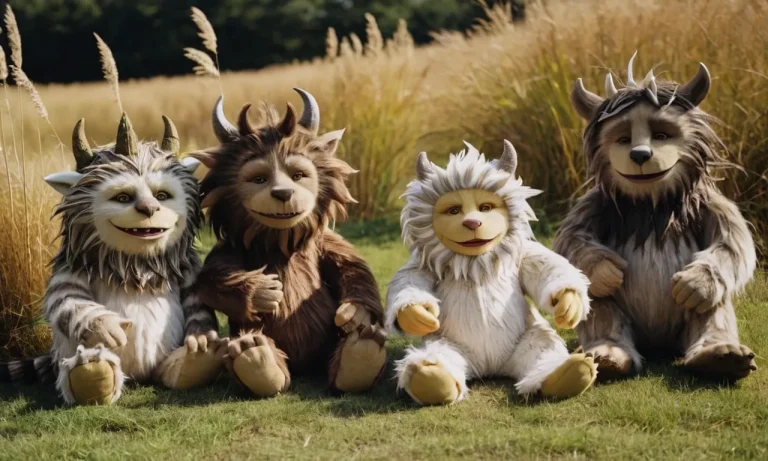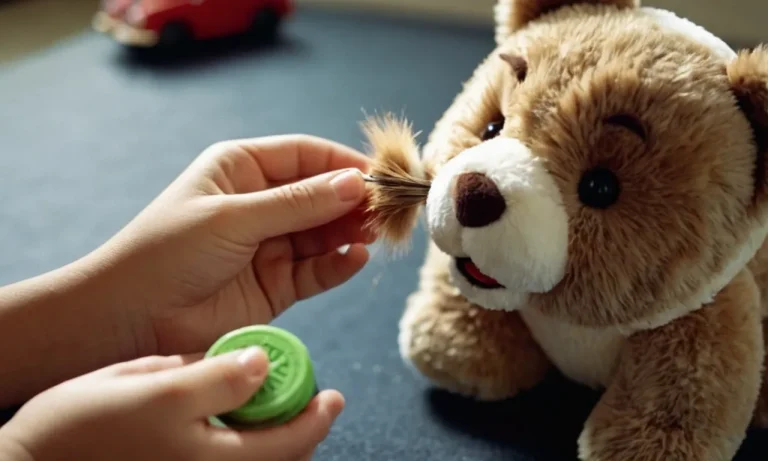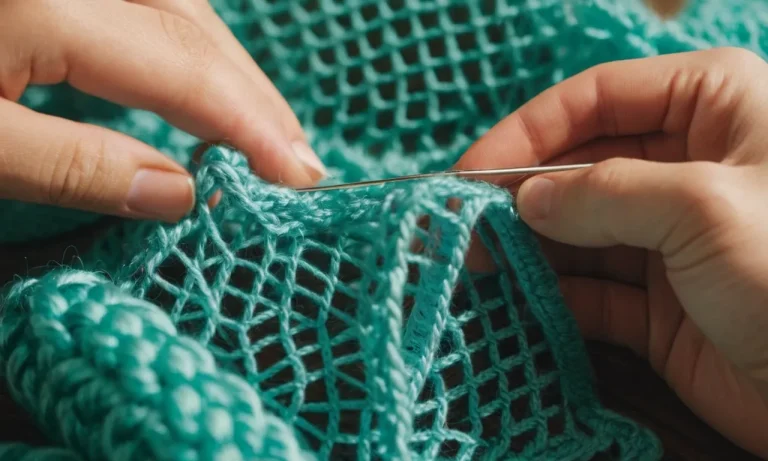Donating used stuffed animals is a great way to declutter while bringing joy to children in need. However, you want to ensure any plush toys are thoroughly cleaned before passing them along.
If you’re short on time, here’s a quick answer on how to clean stuffed animals for donation: Use a disinfectant laundry spray, spot clean any stains with dish soap and a toothbrush, shake off excess water and let air dry completely before donating.
In this comprehensive guide, we’ll cover everything you need to know about prepping plush toys for donation, including:
Assess the Stuffed Animal’s Condition
Check for stains, holes, missing pieces
When going through your stuffed animals to donate, carefully inspect each one for any flaws or damage. Check the fur, fabric, accessories, and stuffing for stains, holes, rips, missing pieces, etc. For furry stuffed animals, be on the lookout for unusual odors lingering in the fur—an indication it could be more difficult to fully clean or sanitize.
Use a bright light to examine all seams and surfaces thoroughly. Also gently squeeze stuffing and batting to see if any powdery fill is escaping through small holes.
Determine if stuffed animal is still safe for play
If the stuffed animal has minor flaws but is still generally intact and cleanable, it may still be fine to donate. However, discard stuffed animals with more extensive damage, very worn out fabrics, exposed batting or stuffing, or safety issues.
A useful guideline comes from the U.S. Consumer Product Safety Commission, which recommends throwing away stuffed animals with broken stitching, exposed batting, missing pieces, or loose parts that could come loose and pose choking hazards.
Decide whether to mend or discard toys that are worn
For stuffed animals that have some minor wear-and-tear but are still cleanly intact, you may choose to mend them before donating. For example, you could patch small holes, repair loose seams or stitching, reattach accessories, or wash away any light stains.
This takes some effort but can save toys that are otherwise still perfectly usable. 😊 However, if the repairs needed are extensive or you can’t fully clean the stuffed animal to “like new” condition, it’s probably better just to thank the toy for the memories and enjoyably discard it.
| Damage Level | Recommended Action |
|---|---|
| Light wear, minor stains, small holes | Clean thoroughly and donate |
| More extensive wear but cleanly intact | Mend if possible and donate |
| Major flaws, ripped seams, exposed stuffing | Discard |
Thoroughly Clean the Plush Toy
Pretreat any stains
If you notice any stains on the stuffed animal before cleaning, pretreat them to improve your chances of removal. Mix a solution of warm water, dish soap, and vinegar, then dip a clean cloth in and dab onto stained areas. Let sit for 5-10 minutes before washing.
Vinegar helps lift stains, while dish soap starts breaking down oils and grease.
Use laundry sanitizer spray
Before the main wash, spray your stuffed friend all over with laundry sanitizer. This kills bacteria and germs that accumulated on the surface over time to leave it fresh and clean. Make sure to thoroughly coat all surfaces including folds, crevices, bottoms of feet, etc.
We recommend Lysol or Clorox laundry sanitizers. 👍
Handwash with dish soap if needed
If the stuffed animal is too large for the washing machine, handwash instead. Fill a sink or tub with warm water and add a few drops of dish soap like Dawn or Palmolive. Submerge the plush toy fully and gently scrub it all over to lift dirt.
Take care around decorative details like eyes to not damage them. Let it soak for 15-20 minutes before draining the dirty water and rinsing clean.
Rinse thoroughly and air dry
After washing, rinse extremely thoroughly with clean water, at least 2-3 times, to remove all soap residue which can leave fabrics feeling stiff or crunchy. Gently press out excess moisture with a towel.
Resist the temptation to machine dry even on air-dry — allow it to fully air dry for up to 2 days to prevent uneven shrinkage issues. Patience pays off for super soft, fluffy results!
Restore Appearance and Shape
Gently brush fur
Before donating your beloved stuffed animals, it’s important to restore their appearance and shape as much as possible. Start by gently brushing the fur with a soft bristle brush or pet comb. This will smooth the fur, remove surface dirt, dust, and lint.
Be careful not to pull or tug too hard, as that could damage the stitching. You can use a sticky lint roller on small areas that are harder to reach with a brush.
If there are visible stains, spots, or smells embedded in the fur or fabric, use a small amount of gentle laundry detergent diluted with water and dab it on the affected area with a clean cloth or soft toothbrush. Avoid submerging the entire stuffed animal in water.
Allow it to fully air dry before brushing again.
Fluff stuffed animal stuffing
Next, check the stuffing inside. Carefully reach into small holes or openings to grab handfuls of stuffing and gently pull, fluff, and rearrange it to restore volume and puffiness. If the stuffing is excessively flattened or compacted, add some new polyfill stuffing to plump it back up.
Just avoid over-stuffing which can cause seams to split.
According to a Good Housekeeping article, 77% of stuffed animals have detectable dust mites after just 2 weeks of use. So fluffing and airing out the stuffing helps remove allergens.
Sew up small holes/tears if possible
Check all the seams and stitching for any small holes, tears, or loose threads. If the damage is minor, hand sew it closed using a needle and coordinating thread color. For larger holes that require special tools, it’s ok to donate as-is if the stuffing is still contained.
Minor imperfections give the stuffed animal character and make it easier for recipients to accept, rather than feeling they took the “perfect” one.
Take a look at this stuffed animal donation checklist for condition guidelines from Boy Scouts of America:
| Condition | Guidelines |
|---|---|
| Holes/Tears | Less than 2 inches |
| Missing Eyes/Nose | OK if otherwise in good shape |
| Stains/Spots | Must not be over 20% of fabric |
| Odor | No unpleasant smells |
With some basic cleaning and repairs, that cherished stuffed pal can bring joy to a child in need. Evaluate each item, but when in doubt, donate. What may not look perfect to you will still look great to the right child.
Pack and Transport Plush Toys
Place in sealable plastic bags
The first step when preparing stuffed animals for donation is to place each one in its own sealable plastic bag, like a Ziploc bag. This keeps the plush toys clean and protected during transport, and contains any dust or loose fibers inside the bag rather than spreading everywhere.
According to the Nationwide Children’s Hospital, individually bagging stuffed animals is vital for sanitation when donating to hospitals or shelters.
Some tips when bagging up plush toys:
- Make sure the bag is large enough to fully contain the stuffed animal without squishing it.
- Seal the bag completely by pressing down on the closure to remove excess air.
- Put fragile stuffed animals or ones with small parts in their own sealed bags separate from larger plush toys to prevent damage.
Use banker boxes or laundry baskets to transport
While individually sealing each stuffed animal is important, you’ll need a larger container to transport multiple plush toys at once. Some good options are:
- Banker boxes – These cardboard file boxes work perfectly to carry sealed bags of stuffed animals. The boxes keep the plush toys organized and contained.
- Laundry baskets – A plastic laundry basket also works well for transporting larger quantities of bagged up stuffed animals for donation.
Line any boxes or baskets with a clean sheet or blanket to keep the plush toys clean. If you have over 20 stuffed animals to transport, divide them between multiple containers so each one isn’t too heavy to carry.
Drop off at local donation centers or charities
Once you have your stuffed animals individually bagged and safely stored in banker boxes or baskets, it’s time to drop them off for donation. Here are some great places to donate plush toys in your local community:
- Women’s shelters
- Children’s hospitals
- Family resource centers
- Youth clubs like the Boys & Girls Club
- Church groups
- Daycare centers or preschools
Call ahead to donation centers or charities to find out if they accept stuffed animal donations and arrange a dropoff time. Make sure to get a donation receipt for any toys you give.
According to research from the American Institute for Economic Research, over 75% of charity groups surveyed rely on non-cash donations like stuffed animals to support their community missions. By properly packing up and transporting your donated plush toys, you ensure they arrive safely to help children in need😊👍.
Conclusion
By properly inspecting, washing, drying and transporting stuffed animals before donation, you can ensure they are safe and clean for a child in need to love.
Just be sure to set aside enough time for the cleaning process. But the effort is well worth it knowing your beloved plush toys will bring happiness in their next home.







